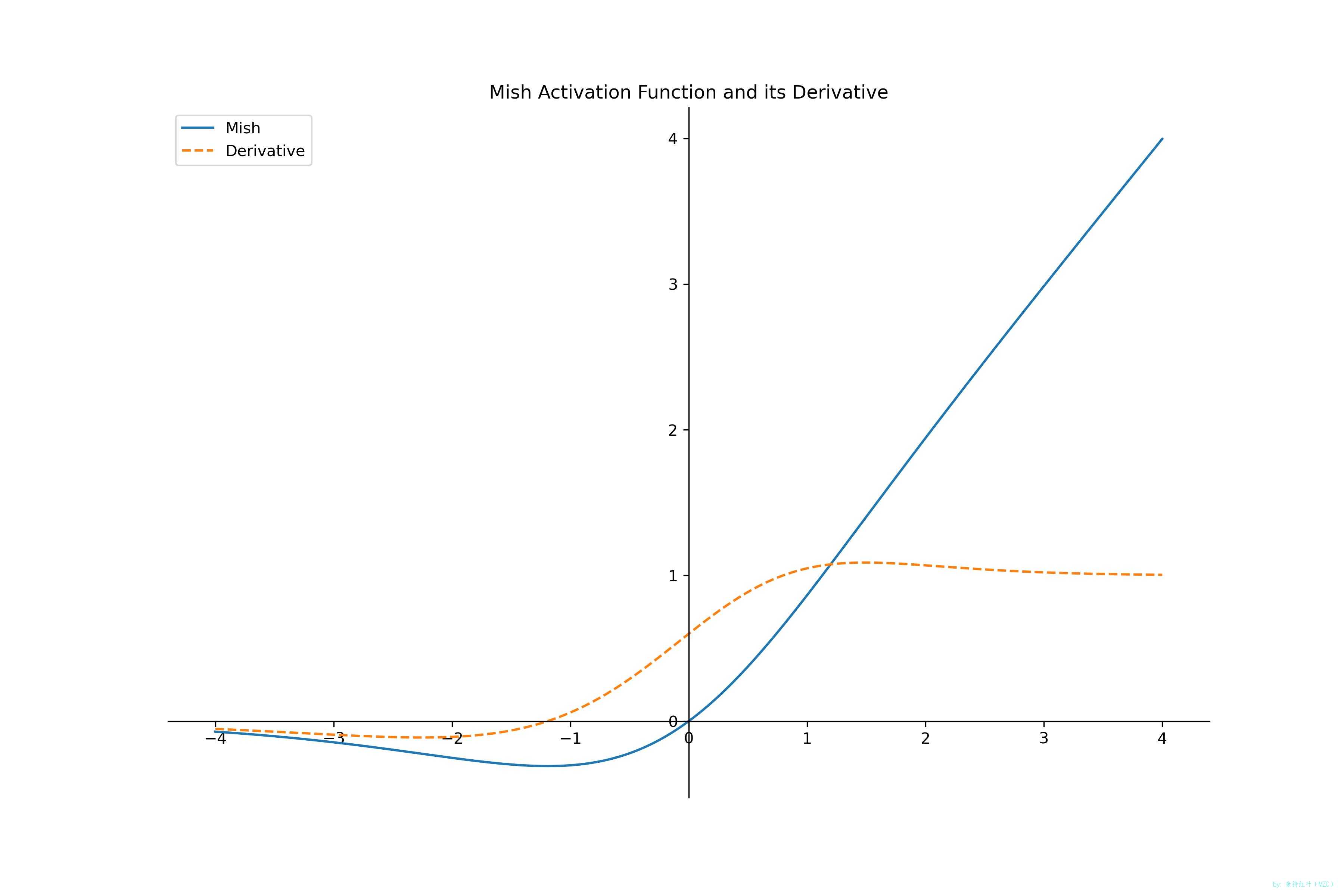文章目錄
- Mish
- 函數+導函數
- 函數和導函數圖像
- 優缺點
- PyTorch 中的 Mish 函數
- TensorFlow 中的 Mish 函數
Mish
-
論文
https://arxiv.org/pdf/1908.08681
函數+導函數
-
Mish函數
Mish(x)=x?tanh??(softplus(x))=x?tanh??(ln??(1+ex))\begin{aligned} \text{Mish}(x) &= x \cdot \tanh\!\bigl(\text{softplus}(x)\bigr) \\ &= x \cdot \tanh\!\Bigl(\ln\!\bigl(1+e^{x}\bigr)\Bigr) \end{aligned} Mish(x)?=x?tanh(softplus(x))=x?tanh(ln(1+ex))? -
Mish函數導數已知:
$$
\frac{d}{dx}\tanh(x) =1- \rm tanh ^2(x) \[2mm]\frac{d}{dx}\operatorname{Softplus}(x)=\sigma(x)=\frac{1}{1+e^{-x}}
$$
參考:神經網絡常見激活函數 2-tanh函數(雙曲正切)
則:
$$
\begin{aligned}
\frac{\mathrm{d}}{\mathrm{d}x}\text{Mish}(x)
&= x \cdot \tanh!\Bigl(\ln!\bigl(1+e^{x}\bigr)\Bigr)\&=\frac{\mathrm{d}}{\mathrm{d}x}x\cdot\tanh\bigl(\ln(1+e^{x})\bigr) + x \cdot \frac{\mathrm{d}}{\mathrm{d}x}\tanh\bigl(\ln(1+e^{x})\bigr) \[2mm]
&=\tanh\bigl(\ln(1+e^{x})\bigr) + x \cdot\bigl(1-\tanh2(\ln(1+e{x})\bigr)\cdot\frac{1}{1+e^{-x}}\
&=\tanh\bigl(\ln(1+e^{x})\bigr) + x \cdot\bigl(1-\tanh2(\ln(1+e{x})\bigr)\cdot\sigma(x)
\end{aligned}
$$
函數和導函數圖像
-
畫圖
import numpy as np from matplotlib import pyplot as pltdef mish(x):"""Mish(x) = x * tanh(softplus(x))"""sp = np.log(1 + np.exp(x)) # softplus(x)return x * np.tanh(sp)def mish_derivative(x):"""Mish'(x) = tanh(softplus(x)) + x * (1 - tanh2(softplus(x))) * sigmoid(x)"""sp = np.log(1 + np.exp(x)) # softplus(x)t = np.tanh(sp) # tanh(softplus(x))s = 1 / (1 + np.exp(-x)) # sigmoid(x)return t + x * (1 - t ** 2) * sx = np.linspace(-4, 4, 1000) y = mish(x) y1 = mish_derivative(x)plt.figure(figsize=(12, 8)) ax = plt.gca() plt.plot(x, y, label='Mish') plt.plot(x, y1, label='Derivative', linestyle='--') plt.title('Mish Activation Function and its Derivative')ax.spines['right'].set_color('none') ax.spines['top'].set_color('none') ax.xaxis.set_ticks_position('bottom') ax.spines['bottom'].set_position(('data', 0)) ax.yaxis.set_ticks_position('left') ax.spines['left'].set_position(('data', 0))plt.legend(loc='upper left') plt.savefig('./mish.jpg',dpi=300) plt.show()
優缺點
-
Mish 的優點
- 平滑無斷點:Mish 函數在整個實數域內連續可導,有助于穩定的梯度流,緩解梯度消失問題。
- 非單調性:負半軸有一段“下凹再回升”的曲線,有助于梯度流動,提升網絡的表達能力。
- 無上界正值:正值部分無飽和區,避免梯度消失,適合深層網絡,有有下界(≈ ?0.31)。
- 實驗性能:在 ImageNet、COCO 等多個基準上,Mish 常優于 ReLU、Swish 等激活函數。(并非絕對)
-
Mish 的缺點
- 計算開銷大:相比 ReLU,需要額外計算 softplus、tanh 與乘法,推理延遲略高。
- 顯存占用:反向傳播需緩存中間結果,顯存開銷高于 ReLU。
- 并非萬能:在某些輕量級或實時任務中,性能提升可能無法抵消額外計算成本,需要實驗驗證。
PyTorch 中的 Mish 函數
-
代碼
import torch import torch.nn.functional as F# 固定隨機種子 torch.manual_seed(1024) # CPU if torch.cuda.is_available():torch.cuda.manual_seed_all(42) # GPU,如果有x = torch.randn(2,dtype=torch.float32) mish_x = mish(x)print(f"x:\n{x}") print(f"mish_x:\n{mish_x}") """輸出示例""" x: tensor([-1.4837, 0.2671]) mish_x: [-0.29912564 0.18258688]
TensorFlow 中的 Mish 函數
-
環境
python: 3.10.9
tensorflow: 2.19.0 -
代碼
import tensorflow as tfdef mish(x):return x * tf.math.tanh(tf.math.softplus(x))# 生成隨機張量 x = tf.constant([-1.4837, 0.2671], dtype=tf.float32) mish_x = mish(x)print(f"x:\n{x.numpy()}") print(f"mish_x:\n{mish_x.numpy()}")"""輸出示例""" x: [-1.4837 0.2671] mish_x: [-0.29912373 0.18255362]







-day23)



)

)





)